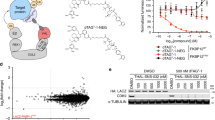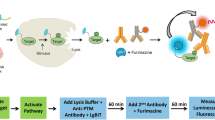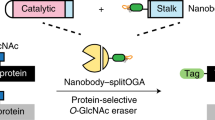Abstract
The ability to selectively interfere with post-translationally modified proteins would have many biological and therapeutic applications. However, post-translational modifications cannot be selectively targeted by nucleic-acid-based interference approaches. Here we describe post-translational intracellular silencing antibody technology (PISA), a method for selecting intrabodies against post-translationally modified proteins. We demonstrate our method by generating intrabodies against native acetylated proteins and showing functional interference in living cells.
This is a preview of subscription content, access via your institution
Access options
Access Nature and 54 other Nature Portfolio journals
Get Nature+, our best-value online-access subscription
$29.99 / 30 days
cancel any time
Subscribe to this journal
Receive 12 print issues and online access
$259.00 per year
only $21.58 per issue
Buy this article
- Purchase on Springer Link
- Instant access to full article PDF
Prices may be subject to local taxes which are calculated during checkout



Similar content being viewed by others
References
Falkenberg, K.J. & Johnstone, R.W. Nat. Rev. Drug Discov. 13, 673–691 (2014).
Ahuja, N., Sharma, A.R. & Baylin, S.B. Annu. Rev. Med. 67, 73–89 (2016).
Biocca, S., Neuberger, M.S. & Cattaneo, A. EMBO J. 9, 101–108 (1990).
Biocca, S. & Cattaneo, A. Trends Cell Biol. 5, 248–252 (1995).
Tanaka, T., Lobato, M.N. & Rabbitts, T.H. J. Mol. Biol. 331, 1109–1120 (2003).
Meli, G. et al. Nat. Commun. 5, 3867 (2014).
Bradbury, A.R.M., Sidhu, S., Dübel, S. & McCafferty, J. Nat. Biotechnol. 29, 245–254 (2011).
Guan, K.-L., Yu, W., Lin, Y., Xiong, Y. & Zhao, S. Nat. Protoc. 5, 1583–1595 (2010).
Visintin, M., Tse, E., Axelson, H., Rabbitts, T.H. & Cattaneo, A. Proc. Natl. Acad. Sci. USA 96, 11723–11728 (1999).
Guo, D. et al. Nat. Biotechnol. 22, 888–892 (2004).
Allouch, A. & Cereseto, A. Amino Acids 41, 1137–1145 (2011).
Visintin, M., Meli, G.A., Cannistraci, I. & Cattaneo, A. J. Immunol. Methods 290, 135–153 (2004).
Cereseto, A. et al. EMBO J. 24, 3070–3081 (2005).
Wongwisansri, S. & Laybourn, P.J. Eukaryot. Cell 4, 1387–1395 (2005).
Robyr, D. et al. Cell 109, 437–446 (2002).
Wan, Y. et al. FEBS Lett. 585, 2519–2525 (2011).
Melchionna, T. & Cattaneo, A. J. Mol. Biol. 374, 641–654 (2007).
Filippakopoulos, P. et al. Nature 468, 1067–1073 (2010).
Dmitriev, O.Y., Lutsenko, S. & Muyldermans, S. J. Biol. Chem. 291, 3767–3775 (2016).
Plückthun, A. Annu. Rev. Pharmacol. Toxicol. 55, 489–511 (2015).
Meli, G., Visintin, M., Cannistraci, I. & Cattaneo, A. J. Mol. Biol. 387, 584–606 (2009).
Persic, L. et al. Gene 187, 9–18 (1997).
Visintin, M., Quondam, M. & Cattaneo, A. Methods 34, 200–214 (2004).
Chirichella, M. et al. PISA screening protocol'a protocol for the selection of intracellular antibodies against post-translational modifications of native proteins. Protoc. Exch. http://dx.doi.org/10.1038/protex.2016.087.
Möckli, N. & Auerbach, D. Biotechniques 36, 872–876 (2004).
Paoletti, F. et al. Arch. Biochem. Biophys. 522, 26–36 (2012).
Acknowledgements
The work was supported by Scuola Normale Superiore institutional funds and by a grant from the European Union Seventh Framework Program (grant no. 604102; Human Brain Project). We are grateful to M.-H. Kuo and D. Guo (Michigan State University, USA) for the H3 tethered catalysis bait, to A. Cereseto (University of Trento, Italy) for the HIV-1 integrase tethered catalysis bait. We acknowledge A. Allouch for helpful discussions about integrase protocols and V. Liverani for help in bait cloning and technical laboratory support. We thank T.H. Rabbitts, J. Zeng, and G. Meli for discussions on the yeast selection procedures. We also thank M. Maffei and R. Ciampi for collaborative logistic help. Many thanks to F. Cremisi and to A. Cellerino for helpful discussions.
Author information
Authors and Affiliations
Contributions
A.C. conceived the project; A.C. and M. Chirichella designed the experiments; M. Chirichella performed all the experiments except for the integrase infectivity assay, which was designed, executed, and analyzed by C.D.P.; M. Chirichella and S.L. performed bait validation, Y2H initial setup, and cDNA library construction; M. Chirichella, S.L., and M.F. executed integrase yeast screening; M. Calvello purified and tested intrabody proteins; M. Chirichella and M.G. performed H3 yeast screening; S.L., M. Chirichella, M.D., and R.B. performed microarray experiment; M.F., I.A., M. Chirichella and M.G. analysed microarray data; M.G. performed RT-qPCR experiments; A.C. supervised work; A.C. and M.C. analyzed and discussed the data. M. Chirichella and A.C. wrote the paper with input from all coauthors.
Corresponding author
Ethics declarations
Competing interests
The authors A.C. and M.C. have filed a PCT patent application which includes data and materials described in this manuscript.
Integrated supplementary information
Supplementary Figure 1 Schematic representation of the PISA selection method.
(a) PISA technology combines chimeric tethered catalysis constructs and IACT method to select intrabodies against a desired acetylated protein target. The protein target is fused to the LexA DNA Binding Domain (LexA DBD), for the two hybrid selection, and to an acetylating enzyme (HAT), for acetylation of the protein target. Acetylation (Ac) of the native-folded protein target is catalyzed in cis, by the wild type HAT enzyme, directly in the yeast intracellular environment. The acetylated protein, fused to LexA DBD, which binds LexA promoter inserted in the yeast L40 genome. When a specific anti-acetylation scFv (from a scFv library) is co-transformed together with the acetylated protein target, yeast growth is permitted, due to the transcriptional activation of HIS3 gene, which is required for L40 strain survival. HIS3 transcription is allowed by VP16 Activation Domain, which is fused to the intracellular scFv. (b) Yeast cells expressing an intrabody (from the scFv library) which is not binding the acetylated protein bait do not grow, since intrabody/bait binding is required for yeast survival. (c) Specificity of the selected scFv anti-acetylation binders is ensured by a counter-screening. The anti-acetylation intrabody candidate (in green) is challenged with a control version of the bait, in which the HAT enzyme is mutated, and the protein target is therefore non-acetylated. In this case, no binding occurs, and no growth is observed. HAT= Histone Acetyl Transferase, DBD=DNA Binding Domain, AD= Activation Domain, ScFv=Single Chain Fragment Variable. The PISA screening, in principle, is not limited to scFv libraries, but functions with repertoires of different binding domains, such as Nanobodies, VH domains, DARPins, or others.
Supplementary Figure 2 Tethered catalysis baits used for PISA screening in yeast.
(a) Schematic representation of tethered catalysis baits for PISA screening. Target antigen is fused at the C-terminus of LexA DNA Binding Domain (DBD) and at the N-terminus of a Histone Acetyl Transferase (HAT) catalytic domain. As descried in Guo et al. (Nat. Biotechnol., 888–892 (2004)), the antigen is post-translationally modified in a constitutive manner by the wild type version of the enzyme (left, screening bait), but it is not modified when HAT is mutated with an inactivating single point mutation (right, control bait). (b) Histone H3 (H3) and Integrase (IN) baits were expressed in yeast and immunoprecipitated with anti-HA antibody (rat monoclonal). After IP, their expression was verified by Western Blot using anti-HA Ab (rabbit polyclonal). Acetylation has also been verified with either an anti-H3Ac antibody or an anti-acetyl-lysine antibody.
Supplementary Figure 3 Expression of control baits and autoactivation assay.
(a) LexA control baits used for epitope mapping are expressed in yeast to investigate their correct expression, as done for the screening baits. The only bait that does not carry a HA tag is LexA-Integrase, whose expression is shown, in the central figure, for two different clones (CFUs). (b) Auto-activation assay for screening and control baits. Yeast baits spotted on histidine-lacking plates in which 3-AT is titrated, allow identification of auto-activation level. The 3-AT concentration, at which non-specific growth (in the absence of an interactor) is arrested, is included in the medium when testing an intrabody interaction. H3 screening bait (LexA-H3-Gcn5wt-HA) needs at least 5mM 3AT, while other control baits are grown at 1.25mM 3AT. As for the Integrase bait panel, LexA-IN-P300wt-HA does not show any auto-activation, unlike LexA-P300wt-HA and LexA-IN which require 1.25mM 3AT.
Supplementary Figure 4 Integrase bait is not acetylated in yeast in the absence of P300wt.
(a) LexA-Integrase bait (IN(1) and (2) on the left are different clones) is expressed at comparable levels as LexA-IN-P300-HA baits on the right part of the panel (anti-Integrase western blot). (b) If the same samples are blotted for anti-acetyl-lysines, signal is detected only in the lane corresponding to the P300 wild type chimera (IN-P300wt-HA).
Supplementary Figure 5 Specificity of anti-Integrase intrabodies.
(a) Yeast growth on histidine-lacking plates (with the addition of appropriate 3AT concentration, a His3 inhibitor) demonstrates interaction specificities for 112A and 12X intrabodies. In particular, it is shown how the splitting of ScFvs in its constituent Variable domains abolishes its cross-reactivity with P300mut for both VH-112A and VH-12X. The panel a illustrates VH-112A to be a specific anti-acetyl-Integrase intrabody, and VH-12X to target Integrase regardless of its acetylation status. (b) Yeasts are restreaked from transformation plates on fresh selective plates. The effect of splitting ScFv-112A variable domains is consistently evident. (c) Beta-galactosidase lift assays performed on restreaked colonies carrying 112A/Integrase prey/bait pairs further confirm the specific acetyl-Integrase binding of VH-112A, compared to its ScFv version. (d) Cross-reaction between P300mut bait and anti-Integrase intrabodies (ScFv-112A and ScFv-12X) is totally suppressed by a low dose of 3AT (1.25mM), which is the same that was used to suppress transactivation of P300wt bait (see Supplementary Figure 3b). The panel shows three independent clones of ScFv-112A and ScFv-12X restreaked from the transformation plate.
Supplementary Figure 6 In vitro acetylation of His-tagged Integrase.
His-Integrase recombinant protein is purified from E. coli and used as a substrate of P300 acetyl-transferase, in the presence of Ac-CoA. Acetylation occurs, in vitro, upon addition of either full-length P300 protein (second lane) or of its catalytic domain only (third lane), with no difference in yield. As a control, a commercial preparation of Histone Cores (lane 4 and 5) is tested with both enzyme variants. Last two lanes demonstrate how addition of mutated, recombinant version of P300 does not induce acetylation of the Integrase protein or Histones. WB in the bottom panel shows comparable levels of His-tagged Integrase in each preparation. Bands at >75kDa reflect auto-acetylation of P300 enzyme, as previously reported in literature. Anti-His WB is used to confirm the presence of the Integrase recombinant protein in its both acetylated and non-acetylated forms.
Supplementary Figure 7 Biochemical and functional validation of VH-12X-HA and VH-112A-HA intrabodies.
(a) Co-IP of VH-12X-HA with His-tagged acetyl integrase versus integrase, using anti-His (left) or anti-HA (right) blotting. (b) HIV infectivity assay. Cytoplasmic localization of the intrabody. Graph shows percentage of GFP+ cells after intrabody transfection and viral transduction. CTRL+ represents the non-transfected control. (c) HIV infectivity assay. Nuclear localization of the intrabody. Graph shows percentage of GFP+ cells after intrabody transfection and viral transduction. CTRL+ represents the non-transfected control. The Kolmogorov-Smirnov test was used to assess the normality of the samples. Then, F test for determining homoscedasticity between samples was applied, followed by appropriate t-test of means comparison. For each comparison, t-test corrections for heteroscedasticity (Welch's t-test) were used when needed. Each experiment was repeated at least twice. Infectivity data shown as whiskers and boxes plots. Boxes of graphs (b) and (c) represent distribution of first to third quartiles, while internal line represents the median. Whiskers represent min and max values. The intrabody transfection efficiency was in the range of 70 +/- 5 %.
Supplementary Figure 8 Epitope mapping of anti-LexA-H3-Gcn5wt-HA intrabodies.
(a) Liquid beta-galactosidase assay shows how ScFv-58F is the only intrabody that is able to recognize the screening bait exclusively. The right panel gives an idea of the interaction strength, which is proportional to color intensity. Values are normalized by subtraction of the negative control (ctrl- in the left figure) and reported as bar chart on the right. Y1 is an anti-LexA intrabody, used as the positive control (ctrl+). (b) Beta-galactosidase filter assay demonstrates the same interaction pattern observed with the liquid assay. Background levels of LacZ due to auto-activation are more evident in the filter assay than in the liquid assay (see the negative control of the H3-Gcn5wt panel).
Supplementary Figure 9 Biochemical characterization of ScFv-58F intrabody and of ScFv-58F-expressing yeast samples.
(a) Co-IP between ScFv-58F-HA and purified His-H3/HisAcH3 proteins (both expressed in E.coli, H3 acetylated in vitro), using anti-HA agarose, followed by anti-HIS Western Blot. Lanes 1-2: bound fraction (quantification in Supplementary Figure 12). Lanes 3-4: unbound fraction. Lanes 6-7: anti-HA agarose immunoprecipitation in the absence of ScFv-58F. Lane 8: loading from the same His-H3 preparation. Inputs and acetylation status are shown on the right. Samples are analyzed with an anti-His-HRP antibody, which cross-reacted with ScFv-58F-HA. (b) Relative quantification by Western Blot of Acetylated Histone H3 in yeast expressing ScFv-58F, ScFv-112A or no intrabody (L40). Acetylated H3 band density from two biological replicates was normalized on Total H3. Data are shown as individual points and mean +/- S.D. N=2.
Supplementary Figure 10 Modified-histone-annotated array specificity analysis.
Data analysis performed with ActiveMotif software for the Histone MODified Annotated Array. ScFv-58F is strongly specificity for the acetylated lysine #9 of Histone H3 over other common modifications. Array is showed in Figure 2a.
Supplementary Figure 11 ScFv-58F binding data and specificity analysis.
(a) Direct ELISA performed with purified ScFv-58F against a panel of H3 histone peptides coated on solid phase. ELISA shows the specificity of ScFv-58F for H3K9Ac. Minor reactivity is observed towards the non-modified N-terminal peptide. (b) ELISA dilution binding curve using 10 μM of acetylated (K9) or non acetylated H3 peptides coated on solid phase and different concentrations of ScFv-58F-HA as probe. (c) ELISA dilution binding curve using native acetylated H3 protein and H3AcK9 peptide, both coated on solid phase. The curves show a concentration range where ScFv-58F binds more effectively to the native acetylated protein than to the acetylated peptide.
Supplementary Figure 12 H3 Immunoprecipitation quantification.
Relative quantification of Western Blot bands obtained in the pull-down assay shown in Supplementary Figure 9a. ImageJ software was used to perform densitometric analysis. Ac= Acetylated; n.a.= non acetylated.
Supplementary Figure 13 Full-length western blot membranes.
(a, b) Membranes from which right panels of Supplementary Figure 9a are derived, showing inputs of in vitro acetylated/non-acetylated recombinant H3 Histone. In (b), anti-His PENTA by Qiagen cross-reacts with BioRad Dual Color marker (cross-reaction seen also in other blots at the dilution of 1:1000 – 1:2000 and for longer exposures). (c) Blot membrane from which Figure 2c is derived. First lane= BioRad Dual Color. From the fifth lane, samples are not relevant to the experiment, and were used as internal controls. (d) Membrane from which Figure 2c is derived. Last lane is another yeast extract used as internal control. (e, f) Western blot membranes of experiments shown in Supplementary Figure 9b. Lanes 5-7 are non-relevant for the experiment. For all gels, BioRad Dual Color marker was used.
Supplementary information
Supplementary Text and Figures
Supplementary Figures 1–13 and Supplementary Tables 1–4. (PDF 1480 kb)
Supplementary Data
Heat map of the significant differentially expressed genes between scFv112A (anti-acIN) and scFv58F (anti H3AcK9) samples. (JPG 4282 kb)
Supplementary Protocol
PISA Supplementary Protocol. (PDF 935 kb)
Rights and permissions
About this article
Cite this article
Chirichella, M., Lisi, S., Fantini, M. et al. Post-translational selective intracellular silencing of acetylated proteins with de novo selected intrabodies. Nat Methods 14, 279–282 (2017). https://doi.org/10.1038/nmeth.4144
Received:
Accepted:
Published:
Issue Date:
DOI: https://doi.org/10.1038/nmeth.4144
This article is cited by
-
Brain histone beta-hydroxybutyrylation couples metabolism with gene expression
Cellular and Molecular Life Sciences (2023)
-
Engineering modular intracellular protein sensor-actuator devices
Nature Communications (2018)
-
Engineering Antibodies
Journal of the Indian Institute of Science (2018)



